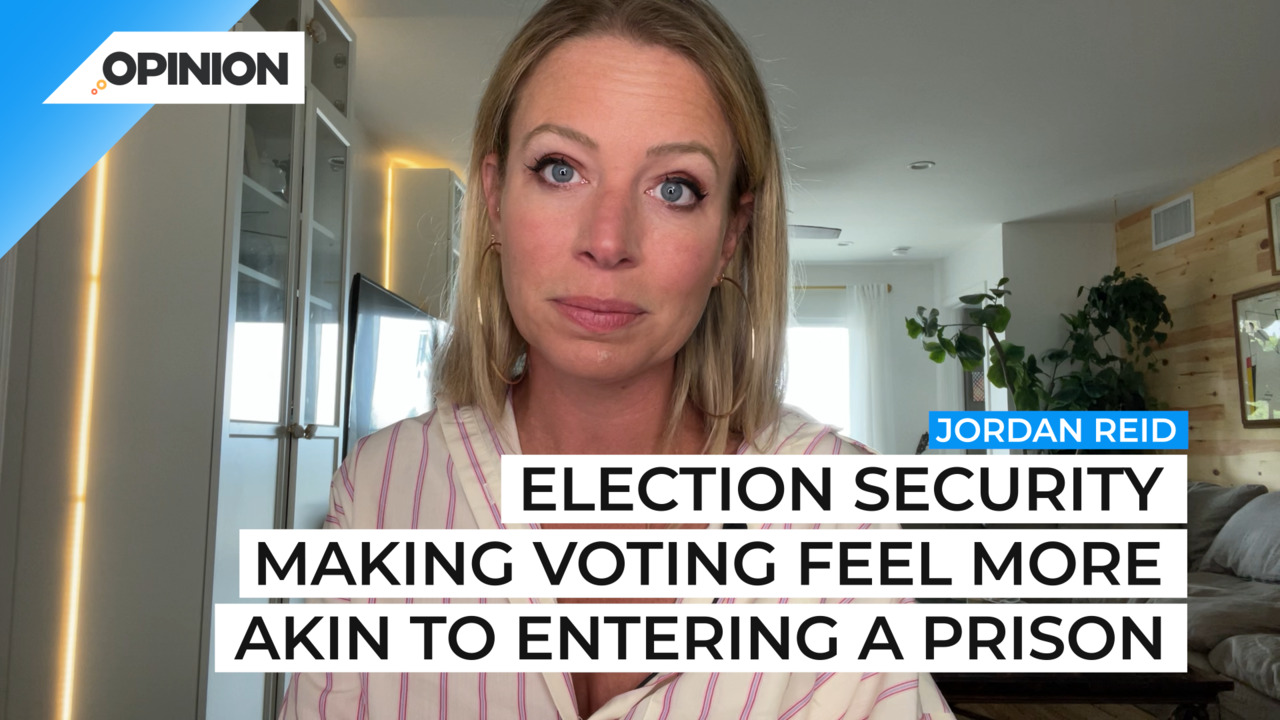
Commentary
-
Our commentary partners will help you reach your own conclusions on complex topics.
I remember the first time I went to vote: It was at a public school on West 46th street, in New York City. I waited outside in the cold with a long line of people who were variously grumpy and excited, and the whole experience was largely…fine. I waited. I was cold. I went in. I voted. I went back home feeling good about having done my civic duty.
Things are a little different nowadays. But before I start in on how and why – because some of this information may be upsetting – I want to underscore that none of the information I’m about to share with you should preclude you from voting. In fact, it should do the opposite.
Now. In the leadup to the November midterms, election officials – spurred by a virtual deluge of threats – are upgrading security protocols to a level that might make voting feel more akin to entering a medium-security prison than, say, a public school. Voters and officials may encounter anything from enhanced security presence to bulletproof glass and panic buttons.
In Tallahassee, Florida, ballot-counters will work out of a building that has been fitted with Kevlar-reinforced walls. In Colorado, the Vote Without Fear act prohibits carrying firearms at polling places or within 100 feet of a ballot drop box.
And offices around the country are implementing active shooter training and coordinating with law enforcement on response protocols – as well as installing tracking devices to monitor ballot movement on Election Day.
In a country that has experienced few instances of election-related violence since the 1960s, this is shocking stuff…except not. We’ve all grown accustomed to the reality of potential violence in situations where it used to seem hypothetical. It’s frightening. And the real-world consequences of that fear are significant.
One in five US election officials say that they are unlikely to stay in their job through 2024, citing stress and fear of retaliation from politicians and the public. Officials are increasing pay and bolstering security to try to offset this development, but there’s another problem here…and that’s that in-person voting is now a thing that some people find scary. Which is, itself, terrifying.
So. If fears of Election Day violence are threatening to upend your plans, here’s what to do. First, vote early, and vote by mail. This also serves to reduce traffic at polling places, making the experience better for everyone.
But if you do choose to vote in person – and that is your right – remember that polling stations are not optimal places for political discourse. Skip the campaign attire, skip debating with the people around you. Keep an eye out for voting disinformation and make sure to get, say, your polling location from a reputable source like eac.gov.
Go in, exercise your right as a citizen, and go home. If you see an instance of voter suppression, report it to your local FBI office or through tips.fbi.gov – do not try to intervene on the spot.
But again, if you take one thing from this segment, it’s not that you should be afraid of voting. If anything, it’s that the current environment only underscores the vital importance of making your voice heard. The midterms are on their way. Make a plan, stay safe, and make yourself heard.
-
Americans must reject Trump to defend our democracy
At the end of the Republican National Convention, Donald Trump accepted the nomination as the GOP candidate for president. In the first part of his acceptance speech, Trump called for unity and healing, although he derailed into partisanship as he continued. Critics have debated the media’s role in handling Trump’s speech. Some argued he was…
-
It’s time for Kamala Harris to pick up the torch
Debates have continued among Democrats about whether President Joe Biden is the best candidate for the 2024 election or whether an alternative Democratic leader might be more electable. While there’s no shortage of fellow Democratic leaders to choose from, President Biden and his supporters have continued to assert that Biden can and will win as…
-
Republicans want to sabotage US education
Former President Donald Trump’s official educational policy platform reveals plans to eliminate the Department of Education and seize the financial assets and endowments of elite U.S. universities. These proposals and others have convinced some liberal critics that the true goal of Republicans is to intentionally weaken U.S. education. Watch the above video as Straight Arrow…
-
Despite poor debate performance, Biden deserves our support
President Joe Biden himself admits that he delivered a “bad” performance in the first 2024 presidential debate. About a week after what some consider to be the worst debate performance in the history of televised debates, polls indicate that more voters than ever have an unfavorable opinion of the president, believe he is too old…
-
The modern-day Republican woman has terrifying role models
In a recent New York Magazine cover story entitled, “How Did Republican Women End Up Like This,” Rebecca Traister writes about some of the more polarizing examples of female Republican leaders and their positions on abortion, the transgender movement and women in general. With Republican women set to play a major role in the November…
Latest Opinions
-
 U.S. Department of Defense
U.S. Department of Defense
Congress still trying to figure out how to reduce wasteful military spending
-
 DVIDS
DVIDS
US Navy, Air Force making waves with new weapons at RIMPAC
-
 Getty Images
Getty Images
Israeli PM Netanyahu meets with Trump at Mar-a-Lago
-
 Getty Images
Getty Images
Growing US nuclear power resurgence reaches the nation’s heartland
-
 Getty Images
Getty Images
Beer from the sun, other solar thermal projects get government funding
Popular Opinions
-
In addition to the facts, we believe it’s vital to hear perspectives from all sides of the political spectrum.


